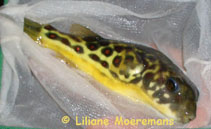| Family: |
Tetraodontidae (Puffers), subfamily: Tetraodontinae |
| Max. size: |
40 cm TL (male/unsexed) |
| Environment: |
demersal; freshwater; brackish, |
| Distribution: |
Africa: endemic to the Cross River in Nigeria (Ref. 7396, 31256, 57417, 81679) and Cameroon (Ref. 51193, 57417, 81679). |
| Diagnosis: |
Dorsal spines (total): -0; Dorsal soft rays (total): 11-12; Anal soft rays: 9-10; Vertebrae: 18-19. Diagnosis: caudal fin truncated or slightly emarginate, its length comprised about 4 times in SL; black-rimmed red ocelli (eyespots) on sides of adults (Ref. 57417).
Description: body short (Ref. 57417), robust (Ref. 81679) and rounded (Ref. 57417, 81679) and able to inflate like a balloon (Ref. 81679). Head long (HL 34.0-40.9% SL); eyes dorsolateral, interorbital distance wide (31.4-41.5% HL)(Ref. 81679). Head and body covered with small spines except on snout and caudal region; two pairs of nasal tentacles (Ref. 57417, 81679). Teeth fused into beak-like structure; no nostrils; lips plicate, with deep furrows; lateral line system obvious as continuous furrows; pectoral fins short and broad; dorsal and anal fins short, with short bases, and positioned together at anterior end of caudal peduncle (Ref. 81679). Caudal fin truncate (Ref. 57417, 81679), about as long as head (Ref. 57417), with 12 rays, including unbranched ray on dorsal and ventral edges (Ref. 81679). Vertebral column strongly arched (Ref. 81679).
Colouration: Live adults: iris orange; belly bright yellow; fins yellow to yellowish brown; dorsum dark brown with several very dark stripes on flanks (Ref. 81679). Variable number of red ocelli edged with black along flanks (Ref. 57417, 81679). Sometimes with dark spots scattered over dorsum (Ref. 81679). Preserved specimens: dorsal half brownish; fins and underside whitish (Ref. 57417, 81679). |
| Biology: |
Juveniles and adults are common in the mainstream river (Ref. 2829). Ventral pocket communicates gill chamber with oesophagus, allowing the fish to inflate its body like a ball (Ref. 57417). Liver and sexual organs are poisonous, but fishermen of the upper Cross carefully remove them and eat the flesh of this species (Ref. 81679). Some references to Tetraodon guttifer in the literature may represent misidentifications of T. pustulatus (Ref. 81679). |
| IUCN Red List Status: |
Endangered (EN); Date assessed: 12 September 2019 (B1ab(iii)+2ab(iii)) Ref. (130435)
|
| Threat to humans: |
harmless |
Source and more info: www.fishbase.org. For personal, classroom, and other internal use only. Not for publication.

